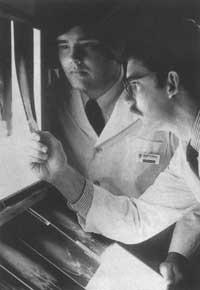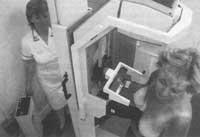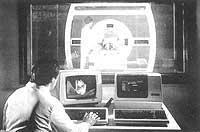Compulsory medical check-ups
1992/07/01 Agirre, Jabier - Medikua eta OEEko kidea Iturria: Elhuyar aldizkaria
The concern to know how our health is is very widespread. To solve these doubts there is no better solution than the realization of some simple tests and, in most cases, harmless, like every three years. The most important thing, as in other cases, is not to devote oneself to extreme positions: not to convert these tests into monthly routines, nor to forget them all, until the moment there is no other remedy.
According to a recent study, most men are convinced that the annual checkup produces more damage and damage than benefits. But women say they have safety because they save many lives.
For years, it has been thought, without a doubt, that the annual checkup was a recommendation in health care, such as vaccination against measles or cleaning with toothbrush. But for most people, all this was nothing more than something that the Americans did in the movies. When any of us went to a doctor asking for a check, the normal thing was to put and send the hypoconia label.
Debates. A little history

There are many who believe that an annual checkup can overcome many hidden diseases before becoming something serious. But, is it true? Not at all, at least if we attend to what was said by the Medical College of North America in 1981. Those responsible for this association, as well as other entities, indicated that it is not necessary to carry out a full annual check.
These statements were the result of hard debates and long scientific research and their impact and impact has not yet been extinguished. Although doctors who completely reject physical exams are few, most consider that only a few are the necessary tests and it is not obligatory to repeat them every year.
The North American Medical Association recommends that healthy adults perform a checkup every five years to 40 years and every three years after that age. But while other institutions continue to say they do it annually, the British Medical Association says it never does.
However, some general guidelines have already been detected, and most specialists advise today:
From 18 to 25 years, checks every four years.From 26 to 45 years, every three years.From 46 to 55 years, checks every two years.From 55 years, annually or by optional prescription.
Medical Abuse: Based on Focus
Studies show that regular studies are the first reason to go to the doctor, up to 20% of total visits. But it seems that the number of visits should be reduced considerably, as will be seen below.
Physicians, for their part, are increasingly selective in the tests they perform. In a time (and not so much the year) the need to use complex and advanced scientific tools to perform a good preventive medicine was recognized almost unanimously, forgetting that the best studies are very simple. Electrocardiograms, stress tests, and even X-rays should not be included in routine checks. Complex medical studies that never end up with all kinds of complex gadgets, are being out of fashion, as they often find problems largely non-existent.
What does that mean? Healthy people may have abnormal results in one test or another. The normal result of an analysis means being within the measure corresponding to 95% of healthy people. Therefore, by definition, even if healthy, 5% of people will find themselves out of these limits of “normality”, even if they are without disease or pathology.
However, if there is no evidence to confirm the diagnosis, the doctor has two options: do more tests (and this solution is usually dangerous and expensive) or ignore the test and think that the patient is a 5% special of healthy. But in these cases, it is up to the doctor to weigh the consequences of an error or error. All this ends with a problematic diagnosis and the patient who is worried (reasonably) will leave the medical consultation.
In this new way of simplification, doctors have reached agreement and there are 4 serious diseases that can be detected in the basic study. The most compelling reasons for conducting regular studies (although not necessarily annual) may be: The frequency or frequency of studies to be performed to detect these four diseases depends on the ages and circumstances of each person and the nature of the test.
Effectiveness of these tests
What are these four diseases? The different types of cancer (cervix, large intestine and breast) and the most common disease in our society: hypertension.
- Cervical cancer, a necklace of uterus, can be detected by a cytology, a simple test that has saved the lives of hundreds of thousands of women. It is recommended that women who currently have an active sex life perform this test once a year.
- Cancer of the large intestine or colon is detected with blood tests in stool. These exams can start around 40 years and should be repeated annually from the age of 50.
- Breast cancer can usually be detected with a mammogram that should be done annually to all women over the age of 40. However, the highway is more effective to detect early small stools in the chest, not forgetting that over time they can be carcinogenic.
- Hypertension is, finally, the main cause of regular control diseases, since if it is not detected and treated on time, it can cause heart and kidney disorders. If a patient has normal stress it is sufficient to control it every two years and every year from 50.
The four “big” are common diseases that can be treated and detected through a simple, precise and safe beta. If a test designed for healthy people does not meet any of these criteria (simplicity, precision and safety), it can be useless and even harmful to health.
Although radiography can detect colon cancer more accurately than blood tests in stool, its degree of radiation is not recommended as a routine test.
In the case of electrocardiogram, although it shows it during the heart attack, it is less effective for its prediction. An extensive research conducted in the United States in 1986 concluded that 73% of people who had suffered heart attacks had previously had normal electrocardiograms (ECG).
However, there are other simple (acceptable) procedures that do not meet all the criteria of the proper test. For example, blood cholesterol measurement is an adequate (simple, accurate and harmless) test to prevent a problem as common as arteriosclerosis.
Above all, remember that the simplest tests do not always serve. Analysis of urine or urine, p. ej., generally not valid for people without symptoms. And the same happens with other tests. Preventive medicine is an annual physical examination, composed of a series of tests or a “battery”, which allows to leave the jack. But there are many doctors who like to see their patients once a year, even if only to maintain the relationship.
The annual consultation, especially in adults, can be a good opportunity to analyze and reflect on the way we live. In the first visit the doctor will complete the medical history, trying to know all the needs of the patient, as well as those of the family: his profession, his education, his hobbies and all his evils (current and even previous). Then perform a complete physical examination and a few simple tests (taking tension, etc. ). ). Finally, the doctor can make a list of problems: sedentary lifestyle, smoking, overweight... The easiest to correct are inadequate habits and customs, so it is worth taking into account and acting on them as much as possible.
The subsequent visits will be quieter, unless there is a problem. Some basic tests are enough, while reviewing the problems that generate your lifestyle (work, hobby, etc. ). Patients see with good eyes the slightest possibility of talking about illness and hangover (for them serious, even if for us it is a nonsense), and emptying indoors (unloading their stresses) can be very useful, more if there are sick people.
It has been proven that an exhaustive annual review is not necessary. It is enough to have a more hardened analysis (done in Tábano, yes) to avoid surprises and problems. The opportunity is always good to educate, advise and renew and update patient/medical relationships. Because nothing reassures and heals the patient more than hearing these magic words by the doctor's mouth.
Basic tests Basic tests Below are some guidelines on the most useful medical tests. They are adapted to the recommendations of the American Medical College of 1985. But this plan is only recommended for healthy people, without special risk factors. If one of these factors exceeds the mean (for example, if the stress is too high), your doctor will probably test you more often. These tests consist of: age, blood pressure, cytology, cholesterol, tuberculin test, blood tests, mammography, and rectal palpation. When there were not so many tests available today, doctors studied their patients through observation (see), auscultation (hearing) and palpation (touching). We still use the senses to check the results of the analysis and in some cases replace them. In the direct examination the doctor “sees” the patient’s brain, blood vessels, and “listens” to the heart. Without any laboratory or x-ray tests, the doctor can diagnose diseases such as diabetes, hypertension, heart disease, arterial hardness or tendency to bleed.
|
The breast: special case

- Once in one of these centers, the gynecologist will make breast palpation following a given order and in the sense of the clock needles. It should also be seen if there is asymmetry between the two breasts and nodal areas (axils, supraclavicular fosses and neck) are also studied.
- The next test is mammography. This is a special chest X-ray, made with higher penetration apparatus. It offers a thorough diagnosis, although in few cases it can provide false negatives. Two different breast projections are usually used: lateral or lateral, one cranium-flow or descending. Due to the need, more specific projections can be used. The specialist usually knows the diagnosis as soon as the mammography is performed.
- Thermography is used when it comes to locating a tumor and knowing its evolution, rather than as a diagnostic method. This is a test to be done a few days after the woman has been naked in a cool environment (18-21ºC) for about 20 minutes, so that the outside heat does not affect the diagnosis. This technique consists of the heat irradiated by the tumorations.
- If a tumor has been found, a followed breast ultrasound will be done to determine whether the tumor is solid or liquid. This test should always be done, since although it is not as exhaustive as mammography, it is a very useful test to complete the diagnosis.
- Another technique used is puncture, which consists of the extraction of liquid and/or cells through a syringe of the tumor. Once seen in the microscope, we will get a more detailed idea of the nature of the tumor. As a technique it is not as aggressive as biopsy, but therefore the risks of damage are also greater in the case of puncture. In fact, the tumor is surrounded by healthy but inflammatory tissue, which can prevent the needle from reaching the malignant zone when there is it.
- When a spill is produced by the titimutor, cytology, microscopic analysis of these fluids or fluids should be done. The results can be known in 24 hours.
- The biopsy consists of making a small opening in the chest and taking a piece of tissue suspected of being tumor. Usually the woman prepares before and so if the biopsy results are positive, that is, the suspicions are confirmed, a mastectomy (or breast removal) or a partial removal is done in the same surgical act, depending on the size of the tumor. Biopsy is the best way to know if the type of tumor and its cells are carcinogenic.
Women who have found a coveted chest or have stable pain should go to the gynecologist. The same is observed if a change of color in the breast (golden or inflamed, blue and with clear veins), if the timuturra towards the interior, if the skin adopts the form of orange skin, even in case of ulceration or minimal bleeding.

Gai honi buruzko eduki gehiago
Elhuyarrek garatutako teknologia



